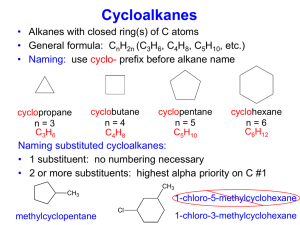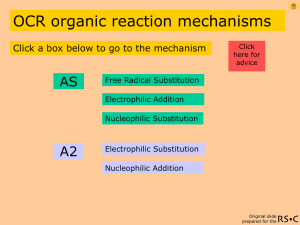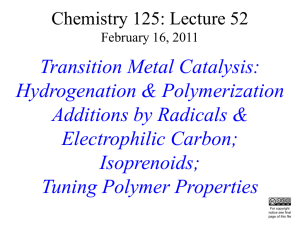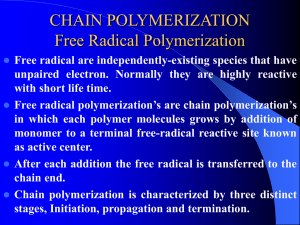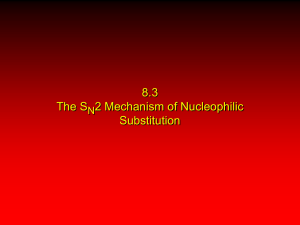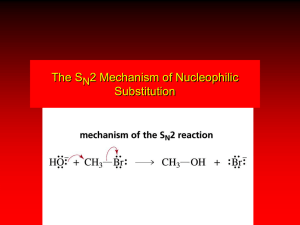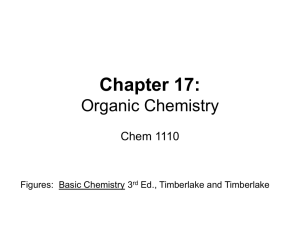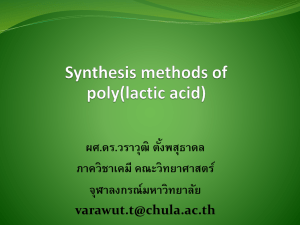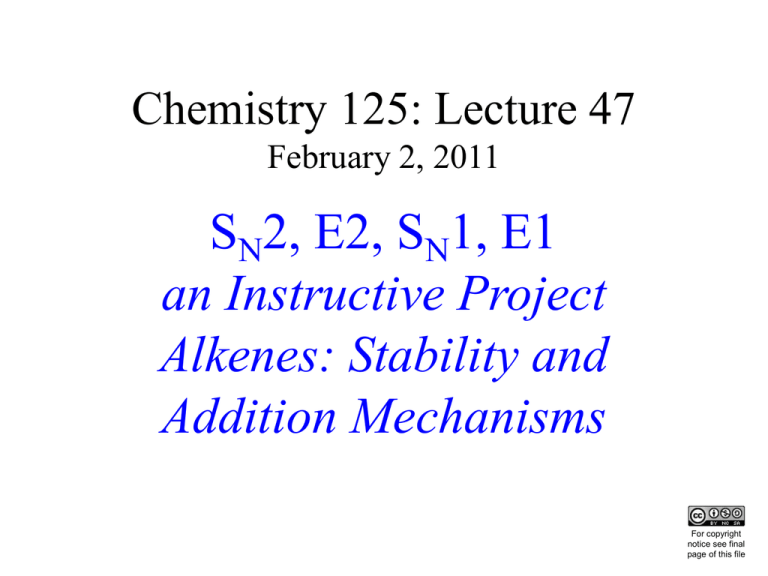
Chemistry 125: Lecture 47
February 2, 2011
SN2, E2, SN1, E1
an Instructive Project
Alkenes: Stability and
Addition Mechanisms
This
For copyright
notice see final
page of this file
(e.g. J&F sec. 7.6-7.8)
SN1 and E1
“Skeletal” Rearrangement
Demonstrates Cation Intermediate
CH3
CH3 C
OH
CH2
Ag+ 3
AgNO
I
CH3
nucleophile
in “SN2”
CH3
CH3 C
H 2O
sC-C as
CH3
CH3 C
+
+
CH2
CH3
1° Cation
(unstable)
-H+
via CH3
CH3 C
+
CH3
C
CH3
CH2
CH3
CH2
CH3
3° Cation
(stable)
CH2
CH3
H
C
C
H
C C
H
C C
H
C
H
C
C
C
H
C
C
C
H
C
“Hyperconjugation”
(s HOMO-LUMO mixing)
LUMO+1
LUMO
HOMO-1
HOMO
Double or Single Minimum?
H
C
H2H
CH
C
C
C
C
H
C
LUMO+1
HOMO
Double or Single Minimum?
H2CH
C
CH3
C CH
3
C
CH3
C CH
3
C
CH3
C CH
3
LUMO+1
HOMO-7
“
Double or Single Minimum?
”
(e.g. J&F sec. 7.6-7.8)
SN1 and E1
H2O:
+
Short-Lived
Ion Pair Gives
Net Inversion!
Cl
Cl-
Cl- temporarily
blocks the
“retention” face.
acetone H2O
OH
HO
80% racemization
40% retention
(should be 100% if there is
a planar intermediate cation)
60% inversion
(0.01 M) NaOH + tBu-Br
EtOH/H2O (4:1)
55°C
HO-t-Bu + NaBr
+ CH2=C(CH3)2
E2 or E1? How do you tell?
Overall rate (not just % alkene) depends on [OH-]
Kinetic Isotope Effect shows whether H is
being transferred in rate-determining step.
5. (5 min) Give a real example of the influence of a change
of reactant structure on the ratio of SN2 to E2 products. Be
as specific and quantitative as you can. (You will need to
show the ratios for two different reactants.)
CH3-Br + OH
(CH3)3C-Br + OH-
Perspectives on Drastic Ratios
Synthetic Organic Chemist : Reliable High-Yield Tool
Physical-Organic Chemist : Definitive Ea Difference
Unambiguous interpretation of cause
e.g. 103 Steric retardation of i-Pr via SN2
vs. 105 acceleration for t-Butyl via SN1
Perspectives on 50:50 Product Ratios
Synthetic Organic Chemist :
Deadly Influence on 12-Step Synthesis
(1/2)12 = 0.02% Yield
(Might provide optimizable lead)
Physical-Organic Chemist :
Valuable “Borderline” Reference
Allows Sensitive Tests of Subtle Influences.
e.g. isotope effect by competition
A valuable lesson
from E2 Elimination
In a Very Viscous Solvent Can Short-Range Motion
Jo-David’s
Question:
Constitute a Rate- (and Product-) Determining Step?
CH3
H3C
•
(1) Rotate
N2 + C4D9
NN
(1) Rotate CH3 NN
CD3
•
(2) Shift D atom
CH3
H3C
CD3
exothermic/easy/fast
• DD
CH3
CD2
CD3
•
N2 + C4H9
CD3
CD3
Radical-Pair
Radical-Pair
“Disproportionation”
If Step
1 (motion) is rate-limiting,
Combination
H- and D-transfer
UVproducts
Light should
(2) Shift H atom
CH
CD
3
3
form in equal amounts.
CH3
exothermic/easy/faster
(because their motions should be equally fast)
H3C
CD3
If Step 2 (atomCH
shift)
is rate-limiting,
3 CD
3
moreGenerates
H-transfersteric
product
should&form.
hindrance
kH/kDmoving
> 1 (kinetic
“isotope effect”)
requires
radicals
past N2
H3C
•
CD3
CH23 H •
CD3
CD3
t-Butylhydrazine
double arrow for
“retrosynthesis”
i.e. prepare from
CH3
H3C
CD3
N
CH3
N
CH3
H3C
CD33
CH
NH
CH3
NH2
CD3
?
To do his project, Jo-David
needed to prepare this compound.
CH3
H2C
CH3
CH3
E2 >> SN2
E1 >> SN1
H3 C
Cl
CH3
NH2
NH2
Smith-Lakritz
It is very common to change
a C=X double bond into
C=O and H2X (we’ll be discussing this)
But+if H
+
Ph2C=N-R Ph2C=O + H2N-R
+
t-Butylhydrazine
CH3
H3C
CH3
CD3
N
CH3
N
H3C
CD33
CH
NH
CH3
CD3
NH2
???
Jo-David Fine
April-October 1971
CH3
H3 C
MgCl
CH3
N
+
O
N
Jo David Fine
Jo-David Fine Notebook p. 91 (October 1971)
Happy Ending I:
“…that project (and my conversation
with that pleasant prof at U Michigan)
did teach me more about the rigors and
foibles
of benchisresearch
than anything
Jo-David
now a respected
thatprofessor
I subsequently
experiencedatas a
of dermatology
postdoc at NIH. It therefore prepared
Vanderbilt, and a world expert
me for many more happily transient
on Epidermolysis
Bullosa.
foibles
during the 19 years
that I ran a
bench immunology lab at UAB and
graduated
from
Yale
UNC. His
As Ison
found
out the hard
way,
in 2000.
trying
to predict ‘good behavior’ with
cell lines, antibodies, and semi-purified
proteins was even more subject to
random whimsy than when I was trying
to work with relatively straightforward
purified chemicals in a far more
structured laboratory setting as an
undergrad.
Jo-David Fine
MD, MPH, FRCP (London)
January 30, 2011
HCl salt easily
purified by
crystallization
Crucial Lesson (from S. Nelsen, U. Wisc.)
CH3
H3C
CH3
CD3
N
CH3
N
H3C
CD33
CH
NH
CH3
NH2
CD3
When you need a compound,
% yield isn’t everything!
CH3
CH3
95%
H2C
H3 C
CH3
Major product a gas,
just “goes away”
E1 / E2
5% SN1
Cl
CH3
NH2
NH2
Cheap!
Happy Ending II :
Jo-David Fine’s successor found that
in fluid solvents, there was more H- than
D-transfer (atom transfer is rate-limiting),
but that in very viscous solvents at low
temperature this “kinetic isotope effect”
disappeared (there were equal amounts
of H- and D-transfer), because motion
had indeed become rate-limiting.
Coverage to Here for
the Exam on Friday
10:30-11:30 in SCL 160
or
10:15-11:15 in SCL 111
Review 8-10 pm this evening
“Electrophilic” Addition to Alkenes
Low LUMO
+
El
reverse of E1/E2 with
some names changed
“For unto every one
that hath shall be
given, and he shall
CH3 have abundance.”
CH3---------Matthew 25:29
Electrophile
H
C
H
H
(Cf. contemporary economics)
C
L
X
Mechanistic/Synthetic Questions: What can you make?
Timing (Concerted or Stepwise)
HOMO/LUMO
or SOMO?
This
Nu
Stereochemistry (Syn or Anti) El and Nu can be the same molecule!
Regiochemistry or Orientation
Leaving
Nucleophile
Group
(“Markovnikov” or “Anti-Markovnikov”)
High HOMO
28:17-31:58
Thermodynamic
Stability of Butenes
http://webbook.nist.gov/chemistry/
Use NIST Webbook to study factors
influencing relative stability of butenes
For high precision convert to a common product, butane, using catalytic
hydrogenation, which is fast and clean, and much less exothermic than combustion.
0 .2
0 .3 6
0 .2 1
0 .2 1
0 .2 1
0 .3 6
0 .1 6
- 1 7 .5
- 1 9 .8 9
- 1 9 .1 5
- 1 9 .6
- 1 8 .7
- 2 4 .6
- 2 2 .4 8
- 2 2 .6 9
- 2 0 .8
- 2 2 .7 3
- 1 8 .7
- 2 1 .3
- 2 1 .7
- 1 8 .8 8
- 2 0 .0 3
- 2 2 .0 8
-21
0 .6
0 .2
0 .2
0 .2
0 .2
0 .3 5
0 .2
0 .2
0 .2
0 .3 5
0 .1 5
0 .3
0 .2 2
0 .2 9
0 .2 1
0 .2 6
0 .1 8
1 .6
3 .6
4 .9
2 .7
3 .9
1 2 .9
7 .2
7 .5
6 .9
1 1 .6
1 0 .0
1 7 .8
6 .9
9 .1
6 .7
7 .3
8 .7
NIST webbook source
DeltaH f (liquid)
(+/-)
0 .6
0 .2
MolMech Strain Energy
- 1 0 .2
- 1 2 .3
- 1 1 .8
- 1 2 .3
- 1 1 .2
- 1 6 .8
- 1 4 .7 9
- 1 5 .1 8
- 1 3 .4
- 1 5 .7 4
- 1 1 .8 2
(+/-)
1 - H exene
2 - H exene, (E )2 - H exene, (Z)3 - H exene, (E )3 - H exene, (Z)2 - Butene, 2 ,3 -dimethyl2 - P entene, 3 - methyl- , (Z)2 - P entene, 3 - methyl- , (E )P entane, 3 - methylene1 - Butene, 2 ,3 -dimethyl1 - P entene, 4 - methyl1 - Butene, 3 ,3 -dimethyl1 - P entene, 2 - methyl1 - P entene, 3 - methyl2 - P entene, 2 - methyl2 - P entene, 4 - methyl- , (E )2 - P entene, 4 - methyl- , (Z)-
Delta H f (gas)
Compound
Isomeric Hexenes
Hf
9 values
Wiberg 1 9 8 1
Wiberg 1 9 8 1
Wiberg 1 9 8 1
Wiberg 1 9 8 1
Wiberg 1 9 9 1
Wiberg 1 9 9 2
Wiberg 1 9 9 3
Wiberg 1 9 9 4
Wiberg 1 9 9 5
Steele 1 9 9 7
Ros s ini 1 9 6 0
Ros s ini 1 9 6 0
Ros s ini 1 9 6 0
Kabo 1 9 7 6
Ros s ini 1 9 6 0
Ros s ini 1 9 6 0
Problem: Are these data consistent with those for the butenes?
End of Lecture 47
February 2, 2011
Copyright © J. M. McBride 2011. Some rights reserved. Except for cited third-party materials, and those used by visiting
speakers, all content is licensed under a Creative Commons License (Attribution-NonCommercial-ShareAlike 3.0).
Use of this content constitutes your acceptance of the noted license and the terms and conditions of use.
Materials from Wikimedia Commons are denoted by the symbol
.
Third party materials may be subject to additional intellectual property notices, information, or restrictions.
The following attribution may be used when reusing material that is not identified as third-party content:
J. M. McBride, Chem 125. License: Creative Commons BY-NC-SA 3.0


